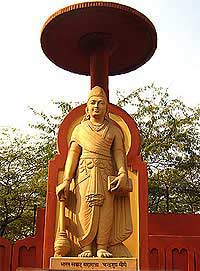Edicts of Asoka
The inscriptions of Asoka were first deciphered by James Princep in 1837. They are written in Pali language and in some places Prakrit was used. The Brahmi script was employed for writing. In the northwestern India Asokan inscriptions were found in Karoshti script. There are fourteen Major Rock Edicts. The two Kalinga Edicts are found in the newly conquered territory. The major pillar Edicts were erected in important cities. There are minor Rock Edicts and minor pillar Edicts. These Edicts of Asoka deal with Asoka’s Dhamma and also instructions given to his officials. The XIII Rock Edict gives details about his war with Kalinga. The Pillar Edict VII gives a summary of his efforts to promote the Dhamma within his kingdom. Thus the Asokan inscriptions remain valuable sources for the study of Asoka and the Mauryan Empire.
POLITICAL HISTORY OF THE MAURYAS
Chandragupta Maurya (322 – 298 B.C.)
 |
| Chandragupta Maurya |
In 305 B.C., he marched against Selukas Niketar, who was Alexander ’s General controlling the northwestern India. Chandragupta Maurya defeated him and a treaty was signed. By this treaty, Selukas Niketar ceded the trans-Indus territories – namely Aria, Arakosia and Gedrosia – to the Mauryan Empire. He also gave his daughter in marriage to the Mauryan prince. Chandragupta made a gift of 500 elephants to Selukas. Megasthenes was sent to the Mauryan court as Greek ambassador.
Chandragupta embraced Jainism towards the end of his life and stepped down from the throne in favour of his son Bindusara. Then he went to Sravana Belgola, near Mysore along with Jain monks led by Bhadrabhagu and starved himself to death.
